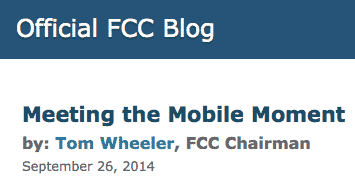FCC 10/17 NOI to Explore Cellular Use in 60 GHz Wi-Fi Band
In a 9/26 blog post Chmn. Wheeler wrote:
“Sustaining the mobile revolution also depends on our invisible infrastructure – spectrum. The fact that there is no low-hanging fruit in our spectrum inventory that can easily be repurposed for broadband means that the Commission needs to think creatively about how to make more spectrum available and increase the efficiency of its use.
Historically, mobile wireless services have been targeted at bands below 3 GHz due to technological and practical limitations. However, there have been significant developments in antenna and processing technologies that may allow the use of higher frequencies – in this case those above 24 GHz – for mobile applications.
Acting on a recommendation of the Commission’s Technological Advisory Council, I am circulating to my fellow commissioners a Notice of Inquiry that seeks to broaden the Commission’s understanding of the state of the art in technological developments that will enable the use of millimeter wave spectrum above 24 GHz for mobile wireless services.
Early studies show that these new technologies – what some are calling “5G” – can ultimately facilitate a throughput of up to 10 Gigabits/second, a speed that is orders of magnitude greater than that available today. Our effort here is to learn about the technology and ensure a regulatory environment where these technologies can flourish.”
While this blog talks about enabling “ the use of millimeter wave spectrum above 24 GHz for mobile wireless services”, reliable FCC sources report that the current draft of the NOI being discussed for adoption on 10/17 includes discussion of the 57-64 GHz band known for WiGig and 802.11ad unlicensed technology for cellular use.
While we have advocated FCC action on long stalled millimeter wave actions, it is not clear if undoing a 1995 decision that made this an unlicensed band is a positive step forward. And while this NOI is credited to the FCC’s Technological Advisory Council (TAC), I just do not see where they even hinted at such action.
Furthermore, the FCC’s 2002 Spectrum Policy Task Force Report, while not binding, recommended that “all future rulemaking for terrestrial use above 50 GHz should include de novo review of the merits of licensing” due to the fact that propagation is so different than at lower bands.
So where did this idea come from?




![Validate my RSS feed [Valid RSS]](valid-rss-rogers.png)

